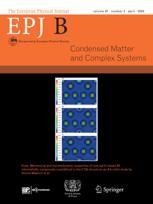Uncovering spin ladders in real compounds
Low-dimensional quantum systems named ‘spin ladders’ are strongly linked to superconductivity. A new theoretical approach has accurately predicted the nature of the spin ladder which appears in real chemical compound – possibly paving the way for new discoveries of advanced superconductors.
New York | Heidelberg, 19 June 2023
 When fabricated in 1 or 2 dimensions, systems of particles whose quantum spins interact with each other can display some unique quantum properties. Through new research published in EPJ B, Asif Iqbal and Baidur Rahaman at Aliah University in Kolkata, India, developed a new theoretical technique for calculating the structures and interactions taking place in these unique materials. Their approach could pave the way for advanced new superconductors – which allow electric currents to flow through them with zero resistance.
When fabricated in 1 or 2 dimensions, systems of particles whose quantum spins interact with each other can display some unique quantum properties. Through new research published in EPJ B, Asif Iqbal and Baidur Rahaman at Aliah University in Kolkata, India, developed a new theoretical technique for calculating the structures and interactions taking place in these unique materials. Their approach could pave the way for advanced new superconductors – which allow electric currents to flow through them with zero resistance.
Acting as an intermediate between 1- and 2-dimensional systems, spin systems feature some unique quantum behaviours. They come in a variety of different types, among the most interesting of which are ‘spin ladders.’ These are made up of 1D chains of particles whose quantum spins, individually named ‘legs,’ are linked together by their quantum interactions – forming the ladder’s ‘rungs’. Crucially, spin ladders behave differently depending on whether their number of legs is odd or even.
Recently, physicists have discovered that superconductivity can be enhanced in spin ladders by carefully introducing impurities into their chemical structures. In their study, Iqbal and Rahaman drew from this research to study a material with the formula Cu2(SeO3)F2. This compound is a known ‘antiferromagnetic’ spin ladder, meaning the spins of neighbouring atoms in the ladder must alternately point in opposite directions.
The duo’s calculations involved ‘density functional theory’: a method widely used in quantum mechanics to study electronic structures, based on the concept that a system’s total energy can be linked to the distribution of its electrons. With this approach, Iqbal and Rahaman found that modelling the material from first principles could accurately reproduce its chemical and structural properties – showing how Cu2(SeO3)F2 behaves as a spin ladder with an even number of legs, with weak interactions between neighbouring spins. The duo now hopes their approach could help researchers to develop advanced new superconductors more easily – potentially leading to advances in cutting-edge areas of research including quantum computing.
Reference: Iqbal, A., Rahaman, B. Electronic structure and microscopic model of Cu2(SeO3)F2: a 2-D AFM ladder compound. Eur. Phys. J. B 96:46 (2023). https://doi.org/10.1140/epjb/s10051-023-00514-1
Further Information
For more information visit: www.epj.org
Services for Journalists
The full-text article is available here.
Contact
Sabine Lehr | Springer | Physics Editorial Department
tel +49-6221-487-8336 | sabine.lehr@springer.com
